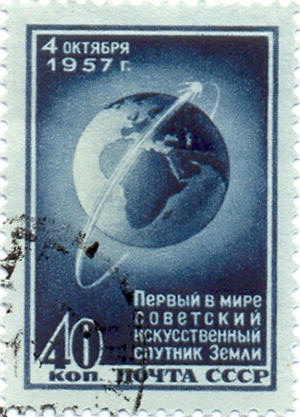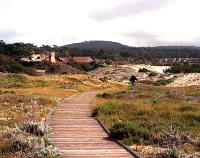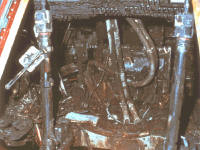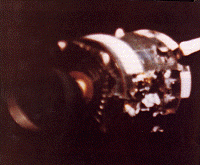Where Were You?
There are events in ones life that is always remembered no matter what else goes on. I have some of these ingrained in my mind.
Sputnik October 4th 1957

Sputnik 1 or Elementary Satellite-1 was the first Earth-orbiting artificial satellite. It was launched into an elliptical low Earth orbit by the Soviet Union on 4 October 1957, and was the first in a series of satellites collectively known as the Sputnik program. The unanticipated announcement of Sputnik 1's success precipitated the Sputnik crisis in the United States and ignited the Space Race within the Cold War.
On the first orbit the Telegraph Agency of the Soviet Union (TASS) transmitted: "As result of great, intense work of scientific institutes and design bureaus the first artificial Earth satellite has been built". The Sputnik 1 rocket booster (second stage of the rocket) also reached Earth orbit and was visible from the ground at night as a first magnitude object following the satellite. Korolyov had intentionally requested reflective panels placed on the booster in order to make it so visible. The satellite itself, a small but highly polished sphere, was barely visible at sixth magnitude, and thus more difficult to follow optically. Ahead of Sputnik 1 flew the third object – the payload fairing, 80 cm (31 in)-long cone, i.e. a little bit bigger than the satellite.
I can remember laying on my back with my Mom and Dad in our backyard watching this strange object move overhead. KFWB would announce the satellite when it was visible over Los Angeles.
Assassination of JFK - November 22, 1963
John F. Kennedy was smiling broadly. Riding through downtown Dallas in a limousine with his wife, Jacqueline, and Gov. and Mrs. John B. Connally, the president waved to smiling faces lining the streets. Nellie Connally turned to him. "No one can say Dallas doesn't love and respect you, Mr. President," she said. "You sure can't," he answered. Minutes later, Kennedy lay crumpled in the back of the limousine, his head, shattered by gunfire, cradled by his weeping wife. In the seat ahead of him, Connally also lay wounded. Nov. 22, 1963, was a day the nation would not forget. It is a day we remember here.
I was at the California Junior College Student Government Association meeting as President of the Student body at Los Angeles City College.
Asilomar was designed by maverick architect Julia Morgan in the early part of the last century. It has been owned by the state parks system since 1956 and is operated by Delaware North Cos.
Parks & Resorts, which also manages Yosemite's Ahwahnee Hotel. Designed in the California Arts and Crafts style, it embodies the movement's harmony with nature, with stately Monterey pines and elegantly sculpted Monterey cypresses scattered among the rooms and conference buildings, and tawny dunes rolling toward a cerulean sea.
Apollo I - January 27, 1967
On January 27, 1967, tragedy struck the Apollo program when a flash fire occurred in command module 012 during a launch pad test of the Apollo/Saturn space vehicle being prepared for the first piloted flight, the AS-204 mission. Three astronauts, Lt. Col. Virgil I. Grissom, a veteran of Mercury and Gemini missions; Lt. Col. Edward H. White, the astronaut who had performed the first United States extravehicular activity during the Gemini program; and Roger B. Chaffee, an astronaut preparing for his first space flight, died in this tragic accident.
A seven-member board, under the direction of the NASA Langley Research Center Director, Dr. Floyd L. Thompson, conducted a comprehensive investigation to pinpoint the cause of the fire. The final report , completed in April 1967 was subsequently submitted to the NASA Administrator. The report presented the results of the investigation and made specific recommendations that led to major design and engineering modifications, and revisions to test planning, test discipline, manufacturing processes and procedures, and quality control. With these changes, the overall safety of the command and service module and the lunar module was increased substantially. The AS-204 mission was re-designated Apollo I in honor of the crew. I was at work at NAA when the news hit us... like a ton of bricks!
Apollo 13 Event - April 11, 1970
The picture above shows the Apollo 13 Service Module after it was released from the Command Module and set adrift in space about 4 hours before re-entry of the CM into the Earth's atmosphere. "There's one whole side of that spacecraft missing", Jim Lovell said as the Apollo 13 astronauts got their first view of the damage that had been caused by the explosion. This blurry photo taken by the astronauts shows the extent of the injury to the Apollo 13 spacecraft, which exposed most of the inside of the service module to space. The Service Module was towed all the way back to Earth after the explosion in order to protect the Command Module heat shield. Another view is shown below.
The Apollo 13 malfunction was caused by an explosion and rupture of oxygen tank no. 2 in the service module. The explosion ruptured a line or damaged a valve in the no. 1 oxygen tank, causing it to lose oxygen rapidly. The service module bay no.4 cover was blown off. All oxygen stores were lost within about 3 hours, along with loss of water, electrical power, and use of the propulsion system. I worked on the program at North American Aviation in Downey and I was at home when the event was reported.... headed back to work within minutes.



